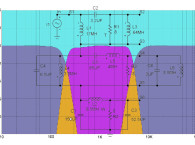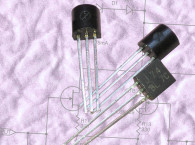- on Theory Articles
- Article
Current Source Amps and Sensitive/Full-Range Drivers - Individual Drivers
Now that you have an overview of the interface network, let’s look at a few individual drivers in more detail.
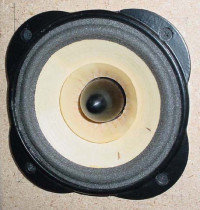 Lowther DX55
Lowther DX55The DX55 probably has the best highend detail among the drivers tested and also enjoyed some of the biggest improvements driven by a current source (Figs. 3 and 4). I consider it the best single excuse to use a current source, and it needs little or no additional damping on the low end, having a small peak in a sealed box. It ended up being the driver of choice for the KleinHorns, since the horns provide enough low-end extension to make up for the small size of the cones, keeping the excursion low. It is not the least expensive Lowther driver at $1095/pair, but I am under the impression that the C55 will get most of this for you at $595/pair, making it more accessible. Keep in mind that subjectively you will probably want R1 at a higher value than on the table, probably between 4.7 and 10Ω.
Lowther DX55 in the KleinHorns
Just as corn chips are simply an excuse to eat salsa, Lowthers provide a reason to build big back-loaded horns. These specimens are about 20′ long and 10′ high, with a 30Hz taper and a 30ft2 mouth (Photo 1). The measurements (Fig. 5) are taken at 6′ because the horn doesn’t develop pressure in the center until you get a ¼ wavelength away, so between the 6′ distance and the mouth size, you expect a rolloff below 50Hz, and you can see it here. Farther away, the bottom extends to 40Hz. The network for the KleinHorn is different from the others in that L0 has a non-zero value, giving low-frequency shelf attenuation - otherwise, the bass below 100Hz overpowers the mid and top.
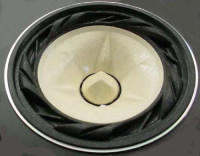 Fostex FE108E Sigma
Fostex FE108E SigmaWe borrowed this from Ed at the Horn Shop, and as far as I can tell he has the world’s supply by virtue of buying up all he can get. This is one of the smaller of the latest editions of the Fostex banana fiber cones. An obvious comparison would be to the similarly sized Lowther DX55, which has much higher efficiency and a more detailed top, but the Fostex has slightly better bass extension. It costs $85 each from Madisound. At that price, it’s easy to check it out for yourself. I gather that it really prefers a rear-loaded horn - not a sealed box - but you can use it either way with good effect.
Fostex FE166E in Abbeys
These enclosures elevate the FE166Es to a highly recommended status. Note that with a current source, you need different values, and a higher damping figure is appropriate. This seems to be a general characteristic of rear loading, and I think you can expect it with most of these drivers. You will probably also find that with a current source and R0 at 10W, a half pound of Dacron sitting in the bottom or end of the pipe smoothes out the bottom a bit. This is not necessarily needed with a voltage source, unless you think the bottom is a bit too much, which is not likely.
Â
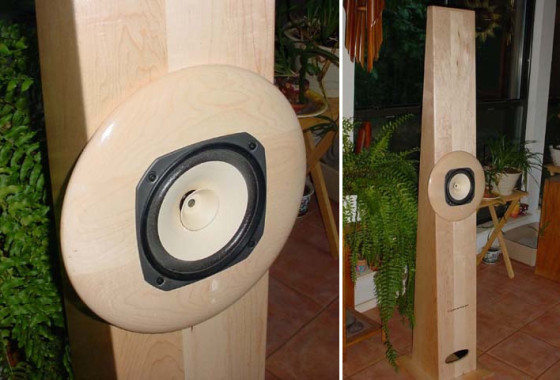
Jordan J92S
The J92S (Photo 2) is not considered a high-efficiency driver, at what appears to be less than 90dB/W, but it is very, very smooth and a wonderful speaker. It excels at one very difficult thing - still sounding good after the honeymoon is over. We got ours at $70 each, and I understand they are twice the price now, but they’re worth it.
Magnetically shielded, they also make great computer speakers. You’ll notice here that the response curves are extremely similar (Figs. 6 and 7). It appears that the high-efficiency drivers make the most out of a current source, and here we don’t see any particular advantage. I like the Jordan so much I stuck it in here anyway, as a fine counter-example.


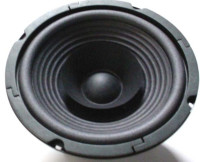 Pioneer BU20F20-51F
Pioneer BU20F20-51FThis speaker gets the prize for “listenable at lowest cost.†It is not as efficient as a Lowther or Fostex, but it has a smooth enough character that’s fairly easy on the ears. It’s not as detailed, but that’s alright if you like lounge music, and it can take more abuse than its more refined competition if you like to dance. Driven by a voltage source, there is a temptation to stick a tweeter on the top, and indeed, an inexpensive ¾″ dome with a 1μF cap just about does the trick.
With a current source, you obviously get more bottom end, and it requires a network to take the top end down to what you see here, which a simple RLC in parallel will accomplish nicely. The R0 value is 23Ω - low enough that if you want to play with these effects without owning a current source amplifier, you can put 25Ω of power resistor in series with the output of a 100W amp and get a Thevenin equivalent of a current source loaded by the same resistance.
Will it sound as good? You have my email address - let me know.
Conclusion
So here we have it - a re-examination of some things that have been known for a long time but with currently available drivers. It’s easy to dismiss the older ways - somewhere in the 1960s the speaker/amplifier interface took a left turn and headed off to high power voltage source amplifiers and speakers designed to lean on them for performance. A small group of iconoclastic cranks has stayed interested in these, and in the end we must recognize fullrange high-efficiency speakers offer elegance, charm, and a different sort of quality.
Current sources and amplifiers with low damping offer interesting possibilities for improvement with these drivers, but they require considerable work getting the enclosures, electrical networks, and acoustic environment just right. Remember, you don’t need to own a current source amplifier to put this information to work - putting R0 in series with the output of a powerful voltage source amplifier instead of in parallel with a current source will give similar results. If R0 is 47Ω or higher, you will want a big amp - 300W - but in any case, be certain to use a high power resistor, say 50W or more.
That said, it’s all just entertainment, and I hope it inspires some of you to have some fun.
Thanks to: Kent English, Desmond Harrington, Jon Ver Halen, Terry Cain, Ed at the Horn Shop, Chris and Matt Williams.
For a complete report on the responses of these and other individual drivers, click here.
www.firstwatt.com | passlabs.com  | www.passdiy.com


